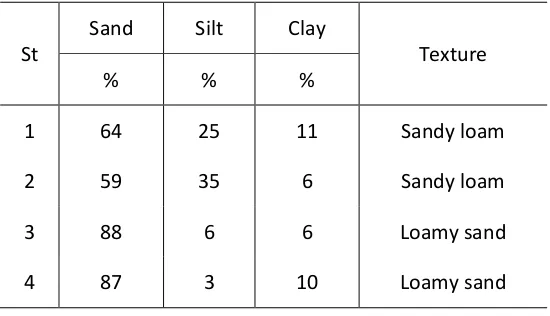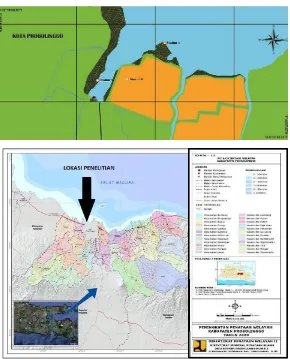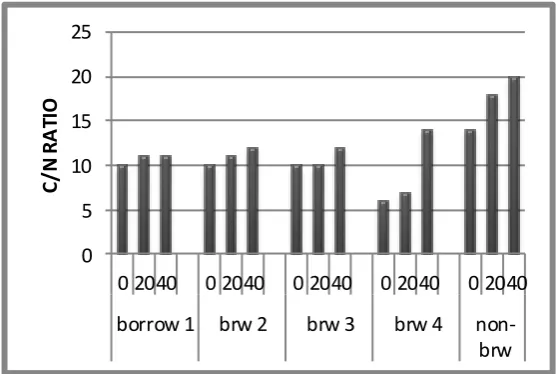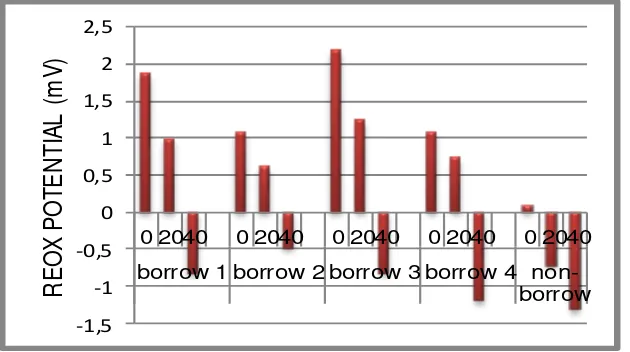The Effects of Fiddler Crabs (
Uca
sp) on C/N Ratio and Redox Potential of
Soil in Mangrove Ecosystems
Mulyanto(1) and Umi Herwati(2)
Fisheries and Marine Science Faculty, University of Brawijaya Email : [email protected] / [email protected]
ABSTRACT
Research has been done in Ketapang mangrove area of Probolinggo city in months of September-November 2015. The objectives are to observe the fiddler crab community stucture and to analyze the effects of fiddler crabs on C/N ratio and redox potential of soil in mangrove ecosystems. The samples of fiddler crabs were taken during the low tides at 4 station (20 transects with sizes of 1 m2). Data of the fiddler crab identified are U. Triangularis between 2 – 6 ind/m2, U paradussumieri 1 – 3 ind/m2, organic matter turnover faster because the high nitorgen content. Soil potential redox (Eh) the undwelled areas was found –0.647 mV, meanwhile the soil Eh in the dwelled areas was positive (0.68 till 0.87 mV). This mean, the decomposition was occured
during aerobic condition and will produce untoxic subtances.
Key words : fiddler crab, C/N ratio, redox potential
INTRODUCTION
The concept of ecosystem engineers was introduced more than a decade ago by Jones, Lawton and Shachak (1994). Organism is called as ecosystem engineers if they can change the material or energy flow and imfluence the number of other species in the ecosystem (Gilad et al., 2004), influence the biogeochemical reaction by changing the availibility of the resources (Gutiérrez and Jones, 2006), create, modify and maintain the environment for theemselves and for other organisms. Based on the mechanisms it can be differenciate (1) autogenic engineers change the environment through (caused by) physical structure, for example a big tree, (2) allogenic engineers change the environment through their activities, for example beaver (Castor canadensis) which uses kinds of logs and branches to build a dam (Miller, Johnson, and Smith, 2008).
organic matter >30, then immobilisation will happen, between 17 – 33 will stabilize immobilisation and mineralization and <17 mineralization will happen, and (2) creating aerob condition in the soil through digging habit for its residency. The existence of burrow possibly provide oxygen in the soil when high and low tide come, which can be detected from the soil redox potential. According to DeLaune and Reddy (2005) in the aerob condition with abundant oxygen, redox potential will be positive and high, can reach up to +400 mV. In the other hand, if there is no oxygen, redox potential is zero or negative. In this kind of condition, nitrate, iron and manganese is in reduced condition, sulphate is stable and there is no sulfite.
Aim of research are study fiddler crab community, analyze the influence of fiddler crab towards soil C/N ratio, and analyze the influence of fiddler crab towards soil redox potential in mangrove area in Ketapang, Probolinggo.
RESEARCH METHOD
This research was done in mangrove area Ketapang Probolinggo on October
2015. The sample taking of fiddler crab was done when it was low tide, 20 transects with each 1 m2 size. The total
density obtained by digging the burrow, then identified and calculated the diversity and dominance.
In the station which is occupied by the fiddler crab, the soil samples were taken from the upper side of the burrow (in the surface), from the burrow wall (depth of 20 cm) and in the bottom of the burrow (depth of 40 cm). Meanwhile in the station that was not occupied, the soil sample was taken from surface area, at depth of 20 and 40 cm. The soil sample was analyzed its texture, C/N ratio and redox potential.
RESULT AND DISCUSSION
Research Location’s Condition
The research location geographically located in 7˚.28.’48”-7˚.57’.00”S and
113˚.10’.48”-113˚.25’.00”E, wide ±2.051 km2, coast length ±921 m, wide mangrove
area ±6,13 ha and fishpond ± 5,6 ha (Figure 1). Soil texture is sandy loam and loamy sand (Table 1).
Table 1. Soil Texture Mangrove Area in Ketapang Probolinggo, October 2015.
St
Sand Silt Clay
Texture
% % %
1 64 25 11 Sandy loam
2 59 35 6 Sandy loam
3 88 6 6 Loamy sand
Figure 1. Research Location Map
Fiddler Crab Community
Fiddler crabs which found in land up to the sea were (a) Uca triangularis, (b) U. paradussumieri, (c) U. perplexa, (d) U. dussumieri dan (e) U. tetragonon (Figure 2).
(a) (b) (c)
(d) (e)
6
Pantai 1 Pantai 2 Pantai 3 Pantai 4
in
d
/m
²
As seen from the density, sequencially from the most one (Figure 3) : (1) U. perplexa 42%, near the land (beach 1) found 32 ind/m², towards the sea (beach 4) lesser 14 ind/m², (2) U. dussumieri 38%, near the shore 12 ind/m², towards the sea (beach 3) more 27 ind/m². According Crane (1975) U. perplexa and U. dussumieri geographically spreaded throughout beach area in Indonesia, (3) U. tetragonan 3 – 6 ind/m², (4) Uca triangularis 2 –6 ind/m². These two crabs can survive as long as there is sea water, therefore many of them are found near land (beach 1 and 2), (5) U. paradussumieri are found the least 1 – 3 ind/m², towards the sea, is nearly not found.
Figure 3. Fiddler Crab Composition
The diversity of fiddler crab in this area is medium and none of them are dominance. comparison between the total of carbon and nitrogen in organic matter, that can be used as indicator of nitrogen availability in the soil. Total carbon is the measurement of the whole organic and inorganic carbon in organic matter. Total nitrogen includes all kinds of nitrogen form, such as N-organic, ammonium-N (NH4-N) and nitrate-N (NO3-N).
Nitrate is commonly contained in low concentration in organic matter which have
not been experienced detritus, and can increase in humus and detritus result (Jones, 2002).
From the research result can be identified that soil C/N ratio location that were occupied by fiddler crabs is quite low around 6 – 14, average 10. In the area that were not occupied by fiddler crab is higher 14
Figure 4. Carbon Ratio –Fiddler Crab burrow’s Nitrogen
Soil C/N ratio is vertically for area that were occupied by fiddler crab, in the surface and depth 20 cm average 9, depth 40 cm average 12. The low C/N ratio in the surface and depth 20 cm can trigger organic matter decomposition faster because of its nitrogen content is higher.
The value of C/N ratio vertically shows
the difference between burrow’s wall soil
condition and soil under the burrow. This
proves that the location of fiddler crab’s
burrow effects the quality of soil organic matter.
Microorganism (bacteria) needs nitrogen to build its body tissue and multiply, where 16% from the protein is nitrogen (Miller, 2000). In the soil with high C/N ratio, bacteria which works in the organic matter detritus process will take the nitrogen from the material which detritused and the short comings will be taken from soil nitrogen storage. This can cause the deficiency of nitrogen, as a result the soil fertility will decrease.
Detritus process rate of organic matter and the number of humus which formed is related to C/N ratio from residue. If the other condition is balance, then the increase of detritus rate, causing C/N ratio
become smaller. Humus which formed from detritus will contain more or less 50% the detritus process grow and breed faster. As the information taken from [email protected] (2011) bacteria uses carbon as energy and nitrogen for building its cell. Optimal comparison from those two elements which needed by bacteria average 30 part of carbon and 1 part of nitrogen or C/N ratio 30. If the C/N ratio is less than 30, bacteria will grow faster and of course the organic matter detritus will also be faster.
Redox Potential
-1,5
borrow 1 borrow 2 borrow 3 borrow 4 non-borrow until +1,78 (average +0,68), next is towards the sea (beach 2) –0,48 until +1,07 (average location that were occupied by fiddler crab even it is positive, it is relatively small, because the depth 40 cm is a sampel which taken from the soil under the burrow of the crab, the reduction condition or anaerobic.
The low redox potential in the location that were not occupied by fiddler crab indicates that the sediment is reductive, this is because of there is no rinsing by sea water intensively and also there is no air This corresponds to Ponnamperuma’s opinion (1978) that the oxydative condition is shown with Eh value which is high and available, iron and manganese in reduction condition, sulphat in stable condition and there is sulfit production, which poisonus to the plant.
One of fiddler crab’s activities is always
digging holes, then some of the hole are left behind. In high tide, rinsing happens and when the water is low oxygen exchanges. This allows the availibity of oxygen so the sediment will be more oxidative. this
corresponds to Krauskopf’s opinion
Figure 5. Redox Potential Fiddler Crab Burrow
(1967) that generally the strongest oxydation agent in nature is oxygen. This condition is different with are which is not inhabited by fiddler crab. While there is tide, the soil pores is filled with water, but rinsing does not occur, and when the water is low, there is air exchange, so some of the soil layers is oxugen less. In this anaerob
reductive condition bacteria’s activity stimulate the ion ferri changes Fe3+
becomes ion ferro Fe2+, pH enhancement,
Eh reduction. In this anaerob condition according to Ponnamperuma (1976) there is a release of CO2, CH4 and H2S.
Redox potential of soil vertically for inhabited area by fiddler crab, in the surface 1,07 until 2,19 (average 1,55), depth 20 cm –0,62 until 1,24 (average 0,75), depth showing that does not contain oxygen. This
corresponds to Kristensen’s opinion et al. (1995) that aerobic oxydation happen near
the sediment’s surface, around the burrow
and along the surface of mangrove’s root
which rich with oxygen. Ponnamperuma (1972 in De Datta 1981) states that oxydation reaction related to the soil condition with a good drainage, while the reduction reaction realted to soil condition with a bad drainage or if there is excess water. Waterlogging can cause reduction condition and reduce the soil Eh value.
CONCLUSION Conclusion
1) Fiddler crabs found are Uca. triangularis 2–6 ind/m², U. paradussumieri 1–3 ind/m², U. perplexa 14–32 ind/m² (mostly 42%, towards the sea the density declines), U. dussumieri 12–27 ind/m² (towards the sea more were not occupied is higher (17). In the surface and depth of 20 cm (9), depth
[email protected]. 2011. Composting 101 : Carbon and Nitrogen. Nevada County 255 So Auburn (Veterans Memorial Building). Grass Valley, California 95945 (530) 273-4563. Crane, J. 1975. Fiddler Crabs of the World.
Ocypodidae : Genus Uca. Princeton University Press, New Jersey: 736 pp. De Datta, S. K. 1981. Principles and Practice
of Rice Production. John Willy & sons. New York. Formation to Habitat Creation. Physical Review Letters. Vol. 93, No. 9.
Biogeochemical Heterogeneity. BioScience 56, 227–236.
Jones, C.G., J.H. Lawton and M. Shachak. 1994. Organisms as Ecosystem Engineers. Oikos 69 : 373 – 386. Copenhagen.
Jones Q.J. 2002. Compost Analysis Report. Agricultural Analytical Services Laboratory. The Pennsylvania State University. University Park PA 16802 Krauskopf. K.B. 1967. Introduction to
Geochemistry. Mc Graw-Hill Book Company. New York.
Kristensen, E., M. Holmer, G.T. Banta, M.H. Jensen and K. Hansen. 1995. Carbon, Nitrogen and Sulfur Cycling in Sediments of the Ao Nam Bor Mangrove Forest, Phuket, Thailand: A review. Phuket Mar. Biol. Cent. Res. Bull. 60, 37–64.
Kristensen, E. 2008. Mangrove Crabs as Ecosystem Engineers; with Emphasis on Sediment Processes. Journal of Sea Research 59 (2008) 30–43
Miller, C. 2000. Understanding the Carbon – Nitrogen Ratio. ACRES USA. Vol. 30, No. 4. Page 20. X
Miller, G.J., S. A. Johnson and L. L. Smith. 2008. Ecological Engineers: Southeastern Pocket Gophers Are One of Nature's Architects. IFAS Extension. University of Florida.
Ponnamperuma, F. N. 1978.
Electrochemical Changes in Submerg Soil. In IRRI, Soil and Rice. IRRI, Los Banos, Philipines.




